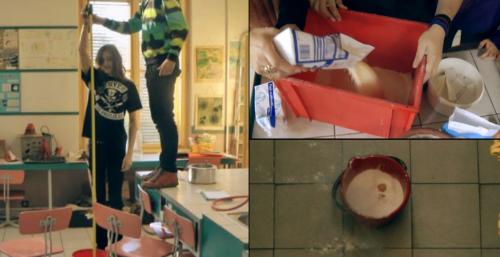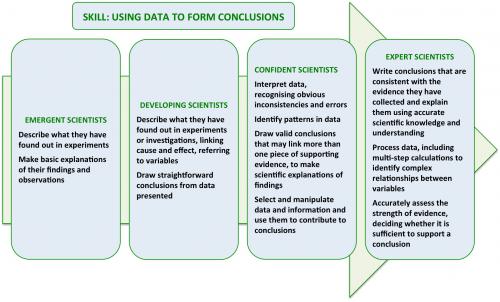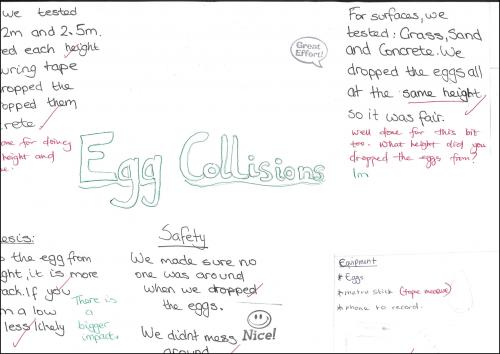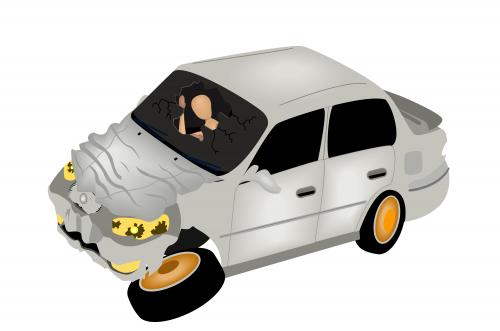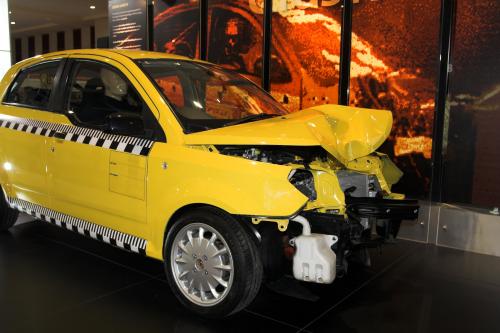The Collision of an egg SAILS inquiry and assessment unit asks the students to solve an unstructured problem in the theme of mechanics - “what factors influence forces during collision?” To understand the interactions during a collision, the students study the impacts on an egg. Two approaches are recommended, first to consider “what factors make it possible for the egg to land safely?” and secondly “From how high can you drop an egg into a bucket of flour, without it breaking?” Through this activity, students explore the connection between force and momentum and can apply this knowledge in the context of road safety.
This unit focuses on the inquiry skill of planning investigations (designing an experiment), in particular considering variables. In addition, students engage in developing hypotheses, and their motivation can be enhanced through immersion in doing science. Working collaboratively with peers is important when developing and implementing the research plan. Possible assessment opportunities include teacher observation, evaluation of student artefacts using rubrics and self-assessment.
This unit was trialled in four countries – Hungary, Denmark, United Kingdom and Germany – producing six case studies (students aged 12-16 years; mixed ability and gender). The teaching approach was open or open/guided inquiry in all cases; students were free to plan the experiment but the materials and equipment were provided. Inquiry skills assessed were planning investigations, developing hypotheses and working collaboratively.
- Mechanics – force and momentum
- Collision of a free falling egg with ground surfaces
- Understanding the relationship of egg collisions with daily life situations
- Identification of effects on the forces during collision
- Designing an experiment – identifying variables, taking measurements
- Lower
- Upper
- Planning investigations
- Developing hypotheses
- Working collaboratively
- Scientific reasoning
- Scientific literacy
- Classroom dialogue
- Teacher observation
- Peer-assessment
- Self-assessment
- Student devised materials
- Presentations
The Collision of an egg SAILS inquiry and assessment unit was developed by the team at the University of Szeged as part of the SAILS project. In this unit, students are asked to solve an unstructured problem. The theme of the task is that of mechanics, the connection between force and momentum, with some reference to road safety. With consideration to the age group and the background knowledge, the calculations may be skipped. The experiment can be most effectively performed by students aged 14-16 years.
Experimentation with the eggs was developed because the speed on impact is easy to control through the selection of the height from which it is dropped. The mass of the eggs is close to constant. With the modification of the surface of impact, it is easy to identify the role of time during deceleration.
Students will learn to plan and implement experiments, be proficient in identification of variables, apply newly learned knowledge to everyday context (e.g. road accidents). There are many opportunities for collisions in sports or on the roads; the altering of forces during these collisions is the basis of developing safety systems. Hopefully the observations by the students will encourage interest in safety.
There are opportunities throughout this unit for the development and assessment of inquiry skills. Evidence of both content knowledge and skill development can be collected in the form of student artefacts (hypotheses proposed, experimental work plan), through teacher observation and self-assessment. While some assessment tools (3-point rubrics) are described within this unit, teachers should be free to devise and implement their own assessment instruments. Suggested skills to be assessed during implementation of this unit include developing hypotheses, planning investigations, and scientific reasoning (drawing conclusions based on evidence).
To ensure adequate time for assessment in class, teachers should do some preparation – prepare an evaluation plan and define the primary points for assessment, implement the task according to given circumstances (adapt as appropriate for your class – based on ability, goals and resources available). In class, teacher should communicate clearly the modes of evaluation that will be used, and should take into account the students' feeling about the evaluation procedures. After class, teacher can give formative assessment in writing, evaluate the suitability of the assessment tools and consult with students and other teachers about the inquiry activity.
Below you can find the full inquiry and assessment unit for download, as well as an archive with classroom materials, including student worksheets and assessment tools for teachers to be used during the activities if available.
Unit booklet Classroom materials| Concept focus |
Mechanics; identification of variables
Egg collisions as a model system for real-world collisions
|
| Inquiry skills focus |
Planning investigations
Developing hypotheses
Working collaboratively
|
| Scientific reasoning |
Identification of variables
|
| Scientific literacy |
Presentation of scientific data
|
| Assessment methods |
Classroom dialogue
Teacher observation
Worksheets
Student devised materials
|
This unit was trialled in four countries producing six case studies of its implementation – CS1 Hungary, CS2 Denmark, CS3 United Kingdom, CS4 United Kingdom, CS5 Germany and CS6 Germany. The teaching approach in all case studies was that of open inquiry or bounded inquiry.
The students involved in the case studies were aged 11-16 years: ranging from just 11 years in CS3 United Kingdom to 16 years in CS4 United Kingdom. The students in each class were of mixed ability and usually mixed gender, although students were all-male in CS5 Germany. CS1 Hungary and CS6 Germany were implemented in a single 90 minute lesson. In the other case studies the unit was implemented over several lessons – CS2 Denmark two lessons, CS3 United Kingdom four lessons, CS4 United Kingdom five lessons and CS5 Germany three lessons. Students worked in groups throughout the activity.
The skill of planning investigations was assessed in all case studies, while developing hypotheses was also identified as a key skill for the assessment. Other assessment opportunities included evaluation of scientific reasoning, looking at students' ability to identify variables or draw conclusions, and scientific literacy, through assessing students' ability to provide scientific explanations for the observed phenomena. The primary assessment methods were classroom dialogue and teacher observation, as well as teacher- and/or peer-assessment of student devised materials and presentations.
The teaching approach varied in the case studies; the unit was mainly implemented as an unstructured problem in CS1 Hungary, CS2 Denmark, CS3 United Kingdom and CS5 Germany (open inquiry), however materials and equipment were provided. In CS4 United Kingdom, students were encouraged to generate a list of equipment that they needed for their inquiry, which was made available in the next lesson for implementation. In CS6 Germany, after having a class-level conversation, the hypothesis to be tested was agreed, nevertheless, students had the freedom to plan their experiments, thus this was a bounded inquiry. Students worked in groups in all case studies; they usually worked in groups of 4; although CS2 Denmark and CS6 Germany did not give exact data.
Even though the unit gives the possibility of assessing several inquiry skills, in real classroom situations teachers are advised to focus on at most two (or in exceptional cases three) inquiry skills. In the case of six groups this might mean 6x2 group-level assessment protocols which in practice seems to be quite a challenge to carry out.
The rubrics presented in the assessment of teaching and learning activities section of the unit served as the basis of formative assessment even when there were deviations from those. The teacher in CS1 Hungary provided formative assessment in class, and reassessed the student artefacts after the inquiry was completed. The teacher then provided oral feedback to the class. This method of assessment was also utilised in CS5 and CS6 Germany. The teacher in CS2 Denmark tried to use what she remembered from the rubrics intended for assessment, but real-life procedures overwrote her plan, and the rubrics became unusable. CS4 United Kingdom reports on conscious deviation from the rubrics given in the unit draft, and the teacher assessed students using her own understanding. CS3 United Kingdom describes the use of rubrics, which were developed in cooperation with the students.
Below you can find the full inquiry and assessment unit for download (excluding the case studies), as well as an archive containing all the case studies.
Unit booklet Case studies| Concept focus |
Application of theoretical knowledge in a practical task
|
| Activities implemented |
Collision of an egg
|
| Inquiry skills assessed |
Planning investigations
Developing hypotheses
|
| Scientific reasoning |
Drawing conclusions
Critiquing experimental design
|
| Assessment methods |
Classroom dialogue
Teacher observation
Student devised materials
|
| Level |
Upper
|
| Age |
15-16
|
| Prior experience with inquiry |
Some experience
|
| Concept focus |
Introduction to IBSE
|
| Activities implemented |
Collision of an egg
|
| Inquiry skills assessed |
Planning investigations
Developing hypotheses
|
| Assessment methods |
Classroom dialogue
|
| Level |
Lower
|
| Age |
13
|
| Prior experience with inquiry |
No experience
|
| Concept focus |
Introduction to IBSE
|
| Activities implemented |
Collision of an egg
|
| Inquiry skills assessed |
Planning investigations
Working collaboratively
|
| Scientific reasoning |
Drawing conclusions
|
| Scientific literacy |
Presentation of scientific data
|
| Assessment methods |
Classroom dialogue
Teacher observation
Peer-assessment
Self-assessment
Student devised materials
|
| Level |
Lower
|
| Age |
11-12
|
| Prior experience with inquiry |
Very experienced
|
| Concept focus |
Recognition of variables to be tested or controlled
Presentation of data
Writing conclusions and evaluation of work
|
| Activities implemented |
Collision of an egg
|
| Inquiry skills assessed |
Planning investigations
Developing hypotheses
|
| Scientific reasoning |
Writing conclusions and evaluations
|
| Scientific literacy |
Presentation of scientific data
Communication of scientific information
|
| Assessment methods |
Classroom dialogue
Teacher observation
Student devised materials
Presentations
|
| Level |
Lower
|
| Age |
12-13
|
| Prior experience with inquiry |
No experience
|
| Concept focus |
Context of crash tests
|
| Activities implemented |
Collision of an egg
|
| Inquiry skills assessed |
Planning investigations
Developing hypotheses
Working collaboratively
|
| Level |
Lower
|
| Age |
15-16
|
| Prior experience with inquiry |
No experience
|
| Concept focus |
Crash test investigations
|
| Activities implemented |
Collision of an egg
|
| Inquiry skills assessed |
Planning investigations
Developing hypotheses
Working collaboratively
|
| Assessment methods |
Classroom dialogue
Teacher observation
Self-assessment
Student devised materials
|
| Level |
Lower
|
| Age |
13-14
|
| Prior experience with inquiry |
No experience
|

